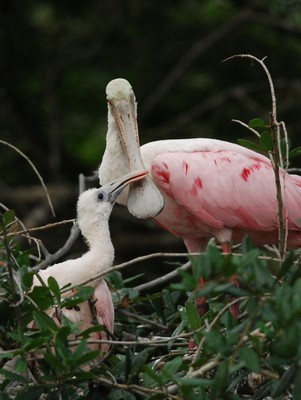
05 Apr The Rookery just got a little more pink

Photo by Bobby V
Written by Lauren Belcher
Roseate spoonbills (Platalea ajaja) are already nesting in the St. Augustine Alligator Farm Zoological Park Native Swamp and Rookery!
Roseates began regularly roosting in The Rookery in 2000. Although their numbers were never great, it is becoming more common to see this species further north due to habitat destruction and poor water management practices in the Everglades region. After roosting for a decade, they finally nested for the first time last April. This year, we have already spotted eight nests in The Rookery which are due to begin hatching out in mid-April!
Roseates are beautiful wading birds that are often mistaken for flamingos because of their bright pink color. Despite their similarities, these birds are not related.
Roseates are usually smaller than flamingos and have one distinct difference which gives them their name: their long, spoon-shaped bill.
In the United States, this spoonbill species is typically found along the south Florida coast – from the Florida Keys north to Tampa. There are also some populations in northeastern Florida and along the coasts of Texas and Louisiana. Due to their limited range and the threat to their remaining habitats, the state of Florida lists this as a species of “Special Concern.”
But, Roseate Spoonbills are considered by the IUCN as a species of “Least Concern” worldwide because this species is plentiful further south in the regions of Central and South America.
Typically, Roseates breed in south Florida from winter to spring (December through February.) If the first nest fails, Roseates will breed a second time in late spring (April through July or August.)
These birds often choose to nest in large trees that are surrounded by water. This is probably why they made a home within the foliage of The Rookery.
Typically, Roseate pairs will construct a new nest each year. The female contributes most to the construction of the nest while the male is the one who goes out and searches for the materials needed.
Roseate nests, like most avian nests, consist of a base and a top. The base is a bulky, loose platform of large sticks while the top is lined with finer plant material such as moss and leaves with a shallow depression in the center for the eggs.
The female will lay her eggs once the nest is nearly completed. After the first egg is laid, incubation starts and will continue for the next 22-23 days. Both the male and female take turns incubating the eggs, occasionally switching out during daylight hours.
The eggs are large and creamy white with spots of brown. All the Roseate parents in the colony will become extremely excitable during hatching periods. Immediately after hatching, the chicks are a pale pink color with a tubular bill.
When you come to The Rookery and see the Roseate chicks there are a few things you can look for. If you see a chick bobbing its head up and down, that’s a form of begging. Shortly after, you may see the parents feeding the chicks by regurgitation.
As the chicks grow, they will develop feathers and eventually their bills will become more spatulate until they resemble a spoonbill. At six weeks of age, the chicks begin fledging and are capable of sustained flight.
It’s an exciting time to be at The Rookery and the 2011 season has only just begun!
